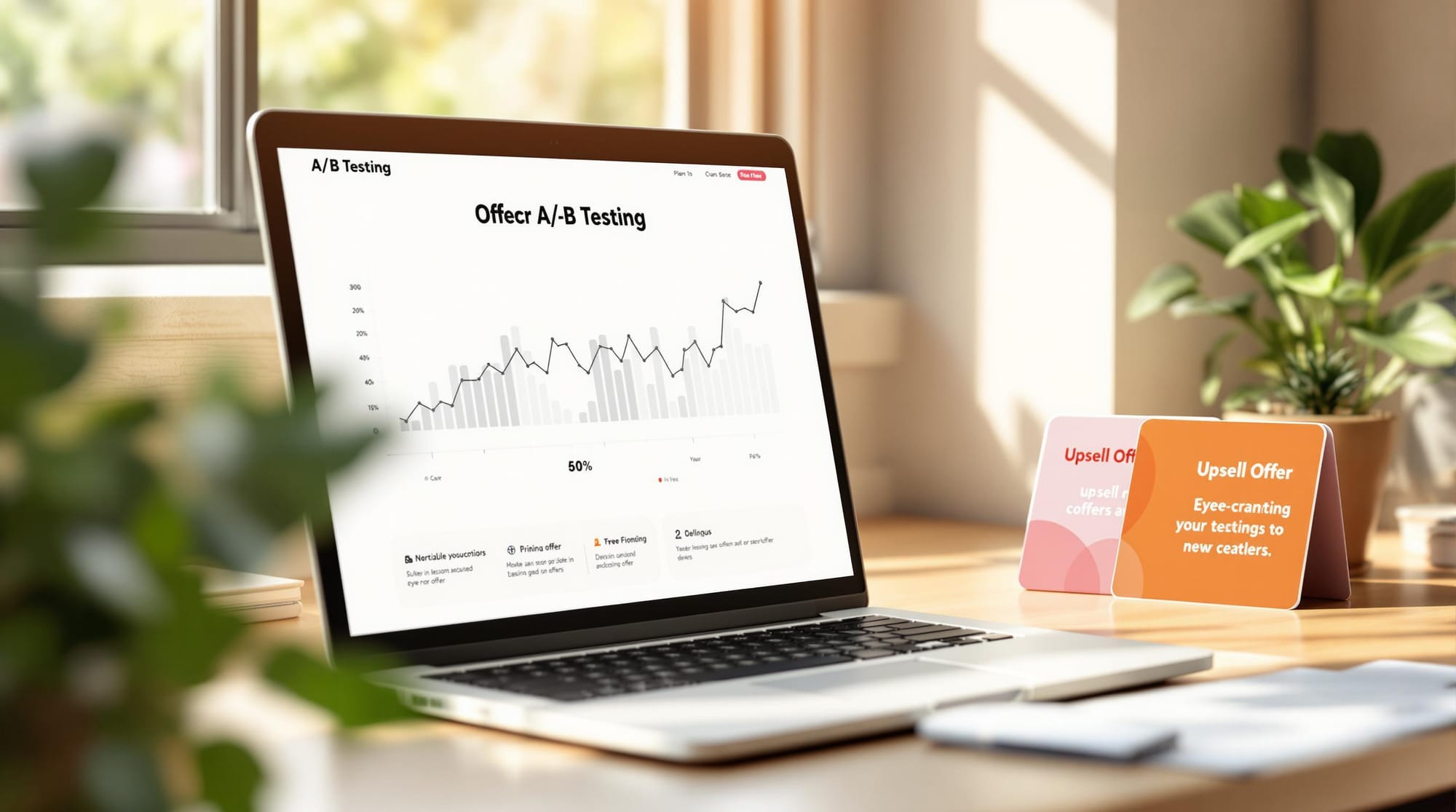A/B Testing Upsell Offers: Best Practices
Learn how to effectively A/B test upsell offers to boost conversions and revenue with proven strategies and tools.

Want to boost your upsell strategy? A/B testing is the key. By testing different variables - like pricing, design, and timing - you can identify what drives conversions and increases revenue. This guide covers:
- What to test: Design, pricing, CTAs, and timing.
- How to test: Use a control group, ensure equal traffic, and achieve statistical significance.
- Key tools: Shopify apps like CRO Cart Drawer & Cart Upsells simplify testing and optimization.
Quick Tip: Focus on one variable at a time and let the test run long enough to gather reliable data. Ready to improve your upsell offers? Let’s dive in!
Steps to Set Up A/B Testing for Upsell Offers
Selecting Variables to Test
Focus on testing one variable at a time to clearly understand its impact . Variables to consider include design, pricing, and timing, as these can influence conversions.
| Variable | Examples | Purpose |
|---|---|---|
| Design | Cart layout, color schemes | Understand how visuals affect user behavior |
| Pricing | Fixed vs. percentage discounts | See which pricing model drives more sales |
| CTA | Button text, position | Measure effect on click-through rates |
| Timing | Pre-checkout vs. post-purchase | Identify the best moments for upsell offers |
Setting Up a Control and a Challenger
Create a control (the current offer) and a challenger (the modified version) . Ensure both receive equal traffic, assign users randomly, and keep conditions consistent throughout the test. Avoid making changes mid-test to maintain reliability.
Choosing the Right Test Duration
The length of your test depends on achieving statistical significance . Key factors include:
- Sample size: Aim for at least 1,000 conversions per variation.
- Traffic volume: Ensure consistent daily traffic to gather meaningful data.
- Seasonal trends: Account for fluctuations that could skew results.
Avoid drawing conclusions too early, as this can lead to misleading results. A well-executed test lays the groundwork for refining your upsell strategy. Once the test ends, analyze the data carefully to implement improvements effectively.
How to Analyze and Use A/B Test Results
Reviewing Key Metrics
After your test ends, it's time to dive into the results and put them to good use. Focus on metrics like conversion rate, revenue per visitor, and cart abandonment to understand how your upsell offer performed. These metrics, which you set up during the testing phase, now guide your next steps.
Check for statistical significance based on the sample size guidelines you used earlier. Look at both the immediate effects and any longer-term trends to get a full understanding of the results.
Applying the Winning Offer
Once you've identified the winning offer, implement it and keep an eye on its performance to ensure it continues to deliver. Make sure to document the elements that worked and their impact for future reference.
Here’s what to focus on:
- Track performance metrics like conversion rates and revenue to confirm the test results.
- Record the successful elements that contributed to the win.
- Use these insights to shape your next round of testing.
Continuing to Test and Improve
Testing doesn’t stop after one success. Keep refining your winning offer by tweaking variables such as timing, placement, and messaging. Regular tests help you stay aligned with customer preferences and market shifts .
Consider these strategies:
- Build on what worked while trying out new variations.
- Use tools like CRO Cart Drawer & Cart Upsells for Shopify to test and implement changes quickly .
- Keep tracking performance metrics to measure ongoing success.
The goal isn’t just to find a winner - it’s to gather insights that will drive your future tests. Once you’ve nailed down a winning offer, focus on improving your strategy to achieve even better outcomes.
Tips for Running Successful A/B Tests
Define Clear Goals and Hypotheses
Start by setting specific, measurable goals for your upsell tests. Instead of saying "increase sales", aim for something like "boost average order value (AOV) by 15% using personalized upsell offers." Your hypothesis should clearly state how a particular change - like offering a free gift - will help achieve this goal.
Having clear goals, expected outcomes, and a defined testing period ensures you gather actionable data.
Avoid Common Mistakes
Testing can go wrong if you're not careful. Here are some common errors and how to avoid them:
| Mistake | Result | Solution |
|---|---|---|
| Testing too many changes at once | Hard to tell what worked | Focus on one variable per test |
| Stopping tests too early | Inaccurate results | Allow enough time for reliable data |
| Overlooking seasonal trends | Misleading insights | Adjust for seasonal differences |
| Changing test settings mid-way | Skewed data | Keep your test parameters consistent |
Steering clear of these mistakes will help you gather reliable insights to fine-tune your upsell strategy.
Use Shopify Tools for Testing

Take advantage of Shopify tools like CRO Cart Drawer & Cart Upsells. These tools provide features like AI-driven recommendations, 1-click upsells, and built-in A/B testing to streamline the process. With customizable options, you can test and optimize offers effortlessly.
Focus on one change at a time, monitor results closely, and use the data to validate your hypothesis.
Conversion Rate Optimisation (CRO): Double Your Sales Through A/B Testing
Using CRO Cart Drawer & Cart Upsells for Better Upsell Offers
Tools like CRO Cart Drawer & Cart Upsells make it easier for Shopify merchants to test and refine upsell offers. This platform provides an all-in-one solution for experimenting and improving upsell strategies.
Key Features of CRO Cart Drawer & Cart Upsells
This platform packs a range of tools to help merchants optimize their cart experience:
- Zero-redirect architecture: Ensures pages load quickly, keeping customers engaged.
- In-cart offer builder: Makes it simple to create upsell offers directly within the cart.
- AI-powered recommendation engine: Suggests products based on customer behavior.
- Dynamic progress bar: Tracks free shipping or gift thresholds, encouraging shoppers to add more to their cart.
A/B Testing Made Simple
The platform includes built-in A/B testing tools, making it easier to experiment with different upsell strategies. You can test various elements to see what works best:
| Test Element | What to Test |
|---|---|
| Offer Timing | Pre-checkout vs. Post-add |
| Discount Structure | Bulk discounts vs. Free gifts |
| Progress Display | Percentage vs. Amount remaining |
| Visual Elements | Different layouts and colors |
By experimenting with these variables, you can discover the most effective ways to engage customers and boost conversions.
Personalizing Offers for Maximum Impact
The customization engine allows you to tailor upsell offers to match your brand identity. Some of the key personalization options include:
- Setting thresholds for free gifts or shipping incentives.
- Configuring cart displays, such as sticky checkout options.
- Adjusting AI recommendation rules to target specific customer segments.
These features help you design offers that align with your brand while testing new ideas. The AI-powered recommendation engine not only suggests products but also allows for detailed testing of different recommendation strategies.
Conclusion and Next Steps
Key Takeaways
A/B testing is a powerful way to improve upsell offers and boost revenue. Using a structured testing method, along with tools like CRO Cart Drawer & Cart Upsells, helps you identify strategies that work best for your audience. These tools simplify the process with built-in A/B testing features, making it easier to experiment and refine your approach.
Success depends on collecting enough data for reliable results (statistical significance) and staying consistent with how you test, analyze, and implement changes.
Action Plan for Shopify Store Owners
Here’s a practical plan to help you get started with A/B testing in your Shopify store:
| Phase | Action Items | Outcome |
|---|---|---|
| Planning | Set clear goals and create hypotheses | A focused and clear strategy |
| Implementation | Test one variable at a time using control groups | Actionable, trustworthy data |
| Analysis | Confirm results meet statistical significance | Informed, data-backed decisions |
| Optimization | Use findings to adjust and improve over time | Ongoing growth and better results |
This step-by-step approach will guide you through the process of running effective A/B tests. While implementing, take advantage of the advanced features in CRO Cart Drawer & Cart Upsells to target your audience more precisely and track key metrics like conversion rates and average order value.
FAQs
What is the control group size for AB testing?
Choosing the right control group size is a key part of A/B testing. It ensures your upsell experiments produce reliable results. A typical approach is a 50/50 split, which creates balanced data for comparison .
| Factor | Recommendation | Reasoning |
|---|---|---|
| Standard Split | 50/50 distribution | Ensures balanced comparison data |
| Large User Base | Smaller percentages | Speeds up testing while staying accurate |
| Small User Base | Stick to 50/50 split | Collects enough data for analysis |
| High-Impact Changes | Larger control group | Reduces risk of misleading results |
For smaller groups, stick with a 50/50 split to gather enough data. If you have a larger audience, you can adjust to smaller groups to speed things up while keeping results valid. Here's what to keep in mind for effective testing:
- Randomize your sample distribution.
- Focus on one variable at a time.
- Give your test enough time to collect meaningful data.
- Keep test conditions consistent.
If you're using tools like CRO Cart Drawer & Cart Upsells, start with a 50/50 split to establish baseline metrics. Even though adaptive testing can adjust in real time, starting with an even split ensures a solid foundation for your experiments.
With a clear control group and proper data collection, you'll be ready to analyze your results and improve your upselling strategies.
